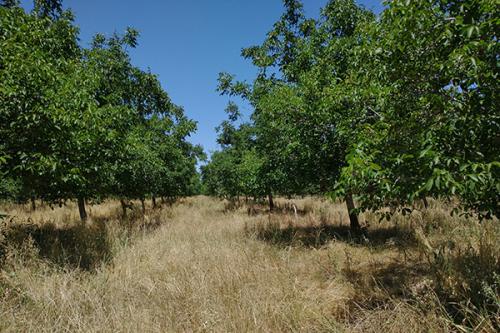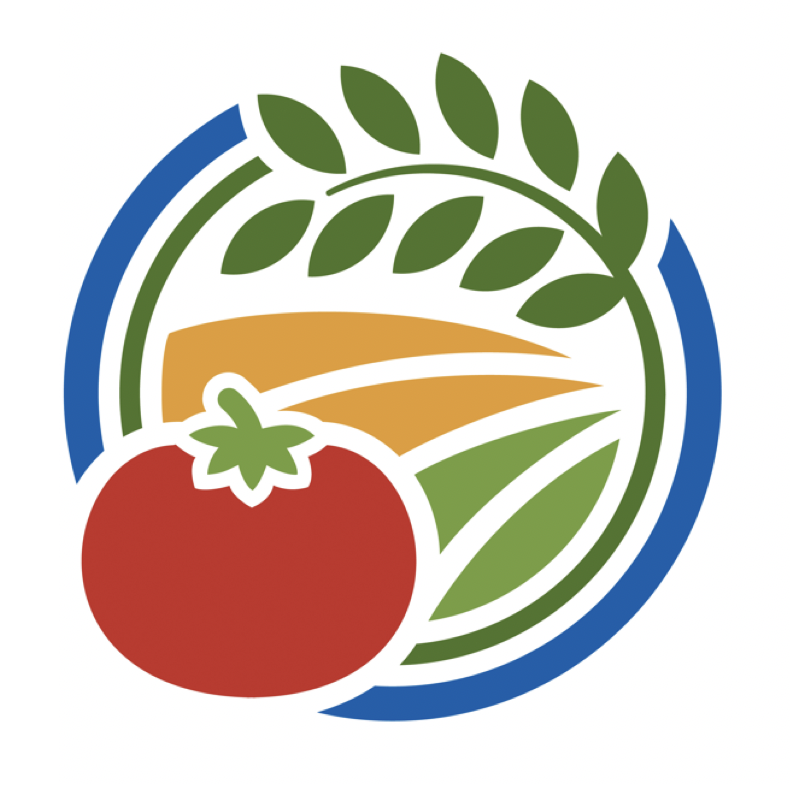
Farm Information
County: Colusa
Location: Sacramento River
Slope: Flat
Irrigation system: Solid set sprinklers
Soil type: Silt loam
Soil detail: Vina loam and Moonbend silt loam
Special farming challenges: nematodes
- Cropping Systems Information
- Crop: walnuts
Acres of orchard or vineyard: 193Other crops: n/a
Acres of other crops: n/a
Organic management: No
Certifications: None
Certifications notes: n/a
Where using cover crops: Walnuts - Grower Experience, Farm Priorities, and Cover Cropping Goals
- When started farming (yr): Before 1995 in S. Dakota dryland farming
Farm priorities: Increase life on the farm, soil health and structure, remaining profitable. Holistic decision-making and management. "It works when you do a whole systems approach. To have a mono-species out there just makes you more dependent on a chemical or conventional system."
Years growing orchard or vineyard crop: ~10 years (but longer for the farm)
Years growing cover crops: 8 years
Initial transition to cover cropping: In 2013 started by having someone bring in a 20 foot drill. Wasn't enough pressure so just spilled on top but ended up with okay germination. Brassicas, bell beans, peas and vetch. Also unknowingly planted walnuts into root lesion nematode-infested ground. Tried multiple chemical products without much success. He knew that some products contain a mustard derivative. So he thought why not directly plant mustard instead? Got around 40% reduction in nematode problem.
Goals and benefits: Nematode control, soil improvement, insect predator support
Benefits description: nematode control, soil health, nutrient cycling, build soil carbon, reduced compaction, beneficial insect habitat (for predaceous mites especially)
Change in goals over time: Also sees the soil benefits, trying to build soils and create more fungal dominance. Mycorrhizae are very important. Also now starting to add sheep.
Reasons: Interseeded legumes as well. Moving towards more grasses to improve soil organic matter. Has to date never planted the same cover crop twice. Soil continues to change year to year, so each new year he wants to address the problems he saw in the last year. - Cover Crop Details, Planting and Management Methods
-
Block described here: Walnuts
Current cover crops: Legumes, grasses, brassicas
Species and mixes: Brassica mix, bell beans, vetch, peas. Recently added grasses
Planting method: Drill seed
Planting date (2020): Did not reseed in 2020, irrigated December 1st for the walnuts and cover crop. Typically would plant after walnut harvest in October.
Was that optimal? Yes
Pre-plant soil prep: n/a
Planting equipment: Vacuum drill, when re-seeding. Doesn't need it that finely calibrated. Put similar-sized seeds into one seedbox together. Mustard and radish seeds go together; bell beans and peas go together; grasses go in their own seedbox. Small-statured plants are planted in the outside rows.
Seeding rate: 20-25 lbs/acre of total seed mix. Typically does not plant as heavily as the local seed company recommends. Some species will take over and crowd out other species. You want to mix seed by percent of total seed count, not by percent of weight of the mix. Otherwise you will plant too much of small-seeded species like mustard.
Seeding depth: about 3/4 inch. At this depth, everything comes up, even small-seeded species. Rule of thumb is to plant seeds 10 times as deep as the width of the seed. Gears overall planting depth for grasses and mustards, as the smallest seeds, and other seeds germinate fine at this depth as well.
Did it germinate well? Yes
Additional management and advice: Uses Green Cover Seed's SmartMix Calculator( online species selection tool) to create cover crop mixes for his specific needs, and then gets the seed from local dealers. Starting to get into sheep grazing and likes them better than roller crimper because they process cover crops into plant-usable forms. He prefers to have sheep graze down ~30% and then trample down the rest to cover the soil. If rolling, you can roll the large plants down early and then clovers will grow through them in the spring. - Cover Crop Termination Methods and Biomass Management
-
Termination method: Roller crimper. Also starting to add sheep grazing.
Termination equipment and process: Roller crimper and row crop shredder (heavier equipment than orchard mower)
Termination date: April 1st - May 15th. Prefers earlier in that range.
Was it optimal? n/a
Biomass management: Leave in place as a mulch. Shred it by July 1. It provides a dimly lit, cool, well-aerated environment which is good for stimulating aerobic biology on orchard floor. - Cover Cropping Challenges and Strategies to Address Them
- Challenges: Vertebrate pests, orchard floor residue at harvest
Challenges description: gophers
Strategies to address challenges: Nothing specific to prevent gophers, but in some years has to clear out cover crop a little more than he would like, in order to level gopher mounds before harvest. Has no problem with harvest residue. Has rolled down mustard as high as 10 ft and shredded it by July 1, and by Oct harvest it is broken down, as long as you can wet the soil surface with sprinklers. Any remaining skeletons of plants blow out at harvest. He sprays herbicide in the tree row in mid-summer (ideally June 15-July 1) to deal with any resident vegetation that grows after cover crop is terminated. Sprays herbicide in the aisles around the beginning of nut drop to clear resident vegetation right before harvest. If he had his own harvest equipment, he wouldn't need to use herbicide, but since he shares equipment, he harvests about 2 weeks later than he ideally would, giving vegetation more time to grow.
Was the cover crop worth it? Absolutely, hands down! We have a high water table. In 2017, the Sacramento River was very high. The orchard was very wet and water was running out, but there was no soil loss, due to good soil condition from the cover crops. Also, you can break even in terms of water use - growing a cover crop has virtually no net negative effect on the water cycle in the orchard. When the soil surface is covered, evaporation from the soil is reduced, and there's only transpiration through the plants.
Least successful past cover crops: n/a
